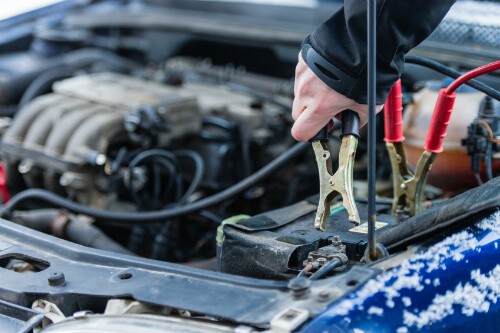Finding your car battery dead can be frustrating, especially when you’re in a hurry. Fortunately, jump-starting your car with jumper cables and another vehicle is a straightforward solution. This guide will walk you through each step to safely and effectively jump-start your car, getting you back on the road quickly.
What You’ll Need to Jump Start Your Car
Before you begin, make sure you have the necessary equipment and a safe environment:
- Jumper Cables: A set of quality jumper cables is essential. Keep them in your car for emergencies.
- A Working Vehicle: You’ll need another car with a functioning battery to provide the jump start. Ensure the voltage of the good Samaritan’s car battery is the same as or greater than your car battery.
- Safety First: Park both cars on a flat surface, ensuring they are not touching. Turn off both ignitions and engage the parking brakes.
Step-by-Step Guide to Jump Starting Your Car
Follow these steps carefully to jump-start your car safely:
- Prepare the Jumper Cables: Take out your jumper cables and untangle them, making sure the clamps are free of dirt and corrosion.
- Connect the Red Clamp to the Positive Terminal of Your Dead Battery: Identify the positive (+) terminal on your car’s dead battery. It’s usually marked with a “+” sign or “POS,” and the terminal itself might be red or larger than the negative terminal. Attach one red clamp to this positive terminal.
- Connect the Other Red Clamp to the Positive Terminal of the Good Battery: Locate the positive terminal on the working car’s battery and attach the other red clamp to it.
- Connect the Black Clamp to the Negative Terminal of the Good Battery: Find the negative (-) terminal on the working car’s battery. It’s usually marked with a “-” sign or “NEG.” Attach one black clamp to this negative terminal.
- Connect the Final Black Clamp to a Grounded Metal Surface on Your Car: This is crucial for safety. Instead of connecting directly to the negative terminal of your dead battery, attach the last black clamp to an unpainted metal part of your car’s engine compartment, away from the battery. A metal strut holding the hood open works well. This grounding point minimizes the risk of sparks igniting battery gases.
- Start the Working Vehicle: Start the engine of the car with the good battery and let it run for a few minutes. This allows some charge to flow into your dead battery.
- Attempt to Start Your Car: Now, try to start your car. If it starts, let it run for at least 15-20 minutes to allow the alternator to recharge your battery. If it doesn’t start immediately, ensure the cable connections are secure and let the working car run for another five minutes before trying again. If it still doesn’t start after several attempts, your battery might be beyond jump-starting and may need replacement.
After a Successful Jump Start
Once your car is running, don’t turn off the engine immediately. Drive for a good 20-30 minutes to allow your car’s alternator to sufficiently recharge the battery. If your car fails to start again the next time you use it, it indicates that your battery is likely not holding a charge and needs to be replaced. Consider visiting a mechanic to test your battery and charging system to diagnose the issue properly.
Jump-starting a car is a helpful skill for any driver. By following these steps, you can confidently and safely jump-start your car and get back on your way. Remember to always prioritize safety and consider battery replacement if jump-starting becomes a frequent necessity.
